Leadership and Management in Health and Social Care Sector
VerifiedAdded on 2023/04/21
|13
|3493
|75
AI Summary
This article discusses the theories of leadership and management in the health and social care sector. It explores the challenges associated with these theories, as well as the motivational theories and influencing factors. The impact of performance management on teams is also discussed.
Contribute Materials
Your contribution can guide someone’s learning journey. Share your
documents today.
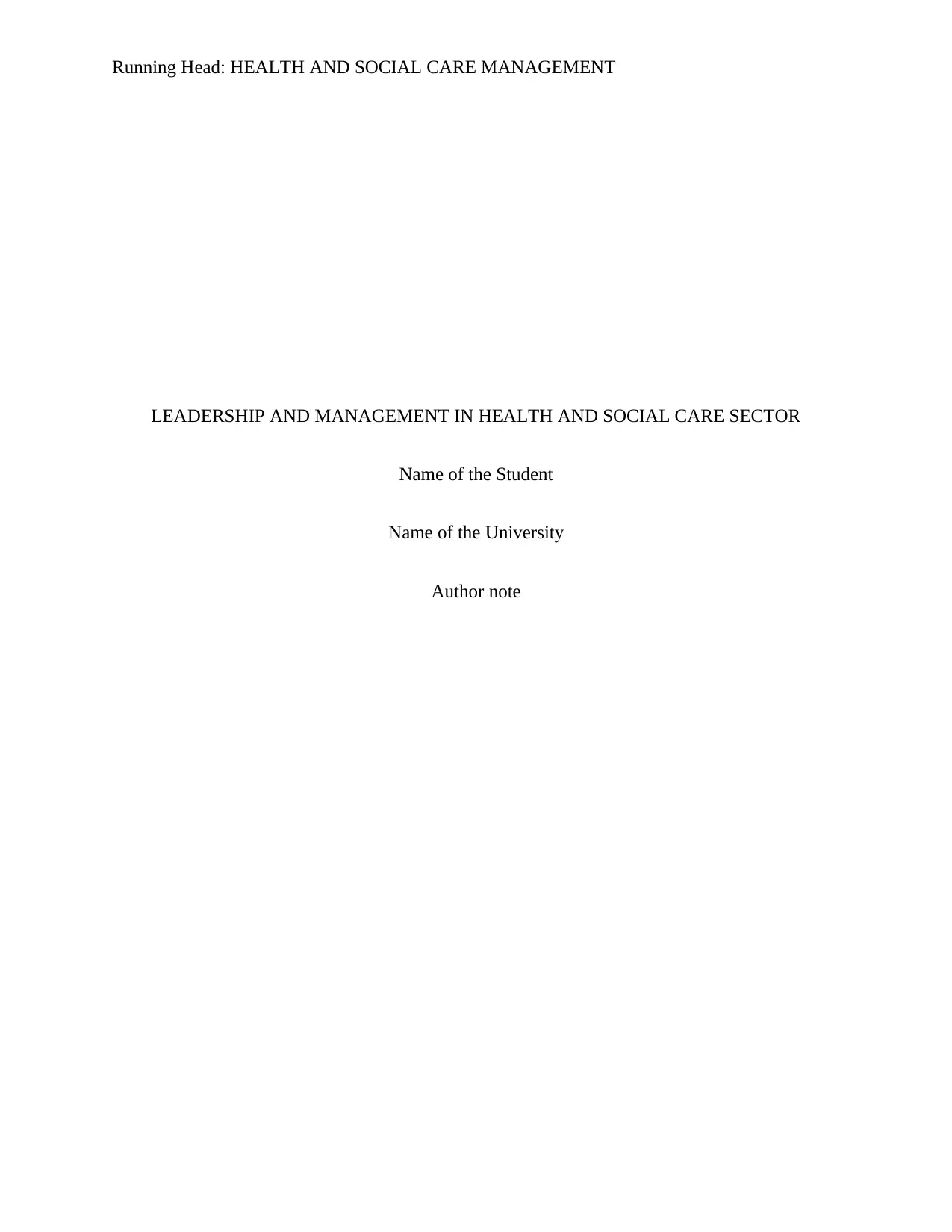
Running Head: HEALTH AND SOCIAL CARE MANAGEMENT
LEADERSHIP AND MANAGEMENT IN HEALTH AND SOCIAL CARE SECTOR
Name of the Student
Name of the University
Author note
LEADERSHIP AND MANAGEMENT IN HEALTH AND SOCIAL CARE SECTOR
Name of the Student
Name of the University
Author note
Secure Best Marks with AI Grader
Need help grading? Try our AI Grader for instant feedback on your assignments.
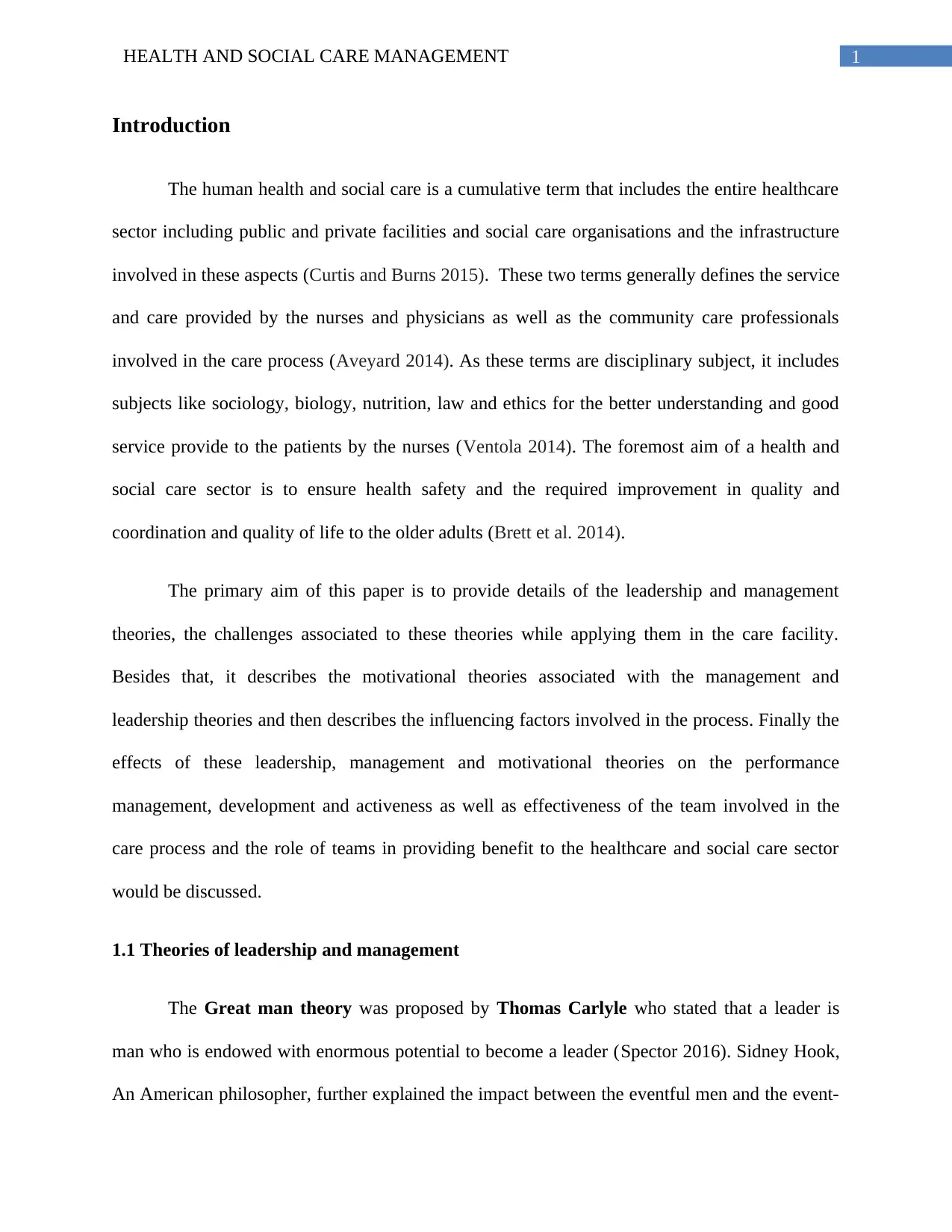
1HEALTH AND SOCIAL CARE MANAGEMENT
Introduction
The human health and social care is a cumulative term that includes the entire healthcare
sector including public and private facilities and social care organisations and the infrastructure
involved in these aspects (Curtis and Burns 2015). These two terms generally defines the service
and care provided by the nurses and physicians as well as the community care professionals
involved in the care process (Aveyard 2014). As these terms are disciplinary subject, it includes
subjects like sociology, biology, nutrition, law and ethics for the better understanding and good
service provide to the patients by the nurses (Ventola 2014). The foremost aim of a health and
social care sector is to ensure health safety and the required improvement in quality and
coordination and quality of life to the older adults (Brett et al. 2014).
The primary aim of this paper is to provide details of the leadership and management
theories, the challenges associated to these theories while applying them in the care facility.
Besides that, it describes the motivational theories associated with the management and
leadership theories and then describes the influencing factors involved in the process. Finally the
effects of these leadership, management and motivational theories on the performance
management, development and activeness as well as effectiveness of the team involved in the
care process and the role of teams in providing benefit to the healthcare and social care sector
would be discussed.
1.1 Theories of leadership and management
The Great man theory was proposed by Thomas Carlyle who stated that a leader is
man who is endowed with enormous potential to become a leader (Spector 2016). Sidney Hook,
An American philosopher, further explained the impact between the eventful men and the event-
Introduction
The human health and social care is a cumulative term that includes the entire healthcare
sector including public and private facilities and social care organisations and the infrastructure
involved in these aspects (Curtis and Burns 2015). These two terms generally defines the service
and care provided by the nurses and physicians as well as the community care professionals
involved in the care process (Aveyard 2014). As these terms are disciplinary subject, it includes
subjects like sociology, biology, nutrition, law and ethics for the better understanding and good
service provide to the patients by the nurses (Ventola 2014). The foremost aim of a health and
social care sector is to ensure health safety and the required improvement in quality and
coordination and quality of life to the older adults (Brett et al. 2014).
The primary aim of this paper is to provide details of the leadership and management
theories, the challenges associated to these theories while applying them in the care facility.
Besides that, it describes the motivational theories associated with the management and
leadership theories and then describes the influencing factors involved in the process. Finally the
effects of these leadership, management and motivational theories on the performance
management, development and activeness as well as effectiveness of the team involved in the
care process and the role of teams in providing benefit to the healthcare and social care sector
would be discussed.
1.1 Theories of leadership and management
The Great man theory was proposed by Thomas Carlyle who stated that a leader is
man who is endowed with enormous potential to become a leader (Spector 2016). Sidney Hook,
An American philosopher, further explained the impact between the eventful men and the event-
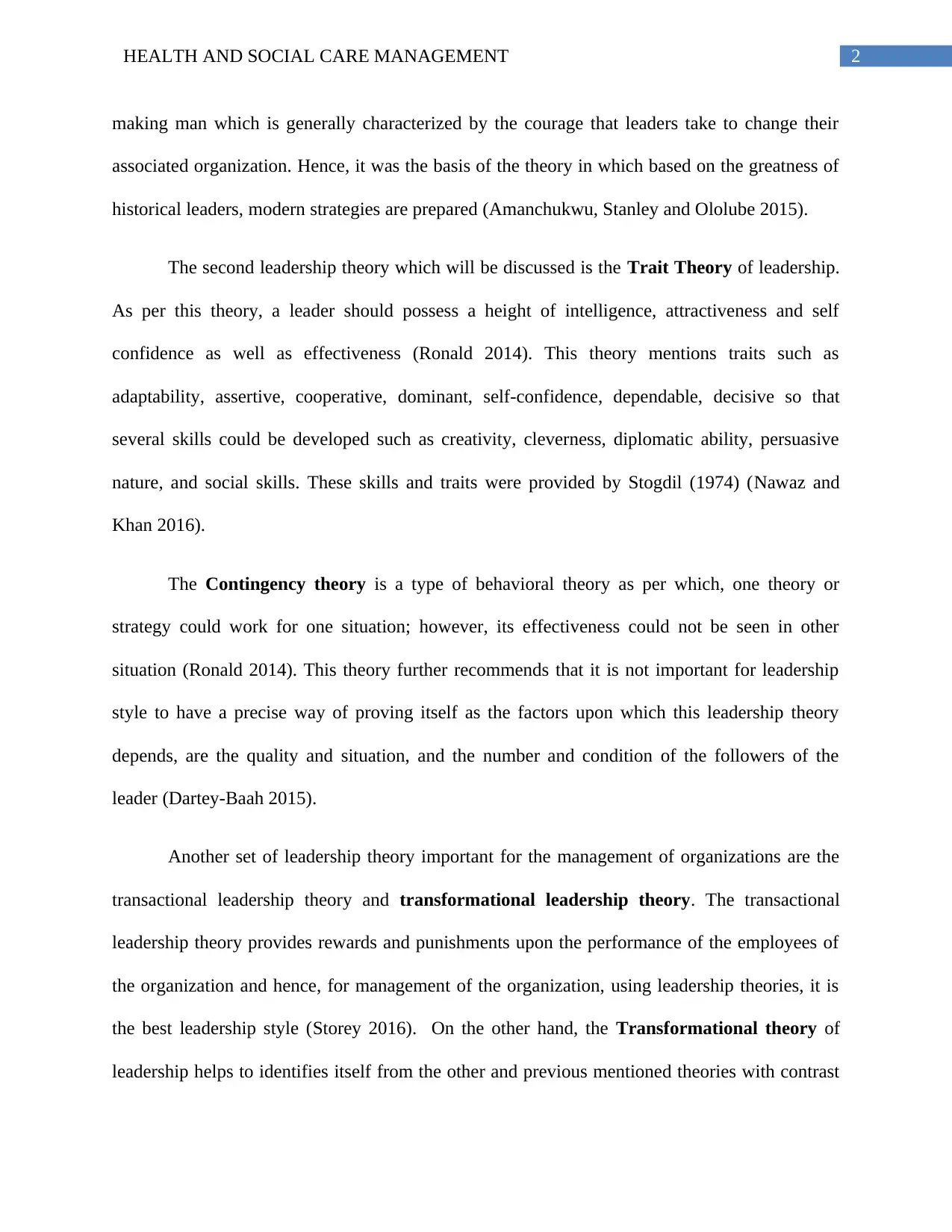
2HEALTH AND SOCIAL CARE MANAGEMENT
making man which is generally characterized by the courage that leaders take to change their
associated organization. Hence, it was the basis of the theory in which based on the greatness of
historical leaders, modern strategies are prepared (Amanchukwu, Stanley and Ololube 2015).
The second leadership theory which will be discussed is the Trait Theory of leadership.
As per this theory, a leader should possess a height of intelligence, attractiveness and self
confidence as well as effectiveness (Ronald 2014). This theory mentions traits such as
adaptability, assertive, cooperative, dominant, self-confidence, dependable, decisive so that
several skills could be developed such as creativity, cleverness, diplomatic ability, persuasive
nature, and social skills. These skills and traits were provided by Stogdil (1974) (Nawaz and
Khan 2016).
The Contingency theory is a type of behavioral theory as per which, one theory or
strategy could work for one situation; however, its effectiveness could not be seen in other
situation (Ronald 2014). This theory further recommends that it is not important for leadership
style to have a precise way of proving itself as the factors upon which this leadership theory
depends, are the quality and situation, and the number and condition of the followers of the
leader (Dartey-Baah 2015).
Another set of leadership theory important for the management of organizations are the
transactional leadership theory and transformational leadership theory. The transactional
leadership theory provides rewards and punishments upon the performance of the employees of
the organization and hence, for management of the organization, using leadership theories, it is
the best leadership style (Storey 2016). On the other hand, the Transformational theory of
leadership helps to identifies itself from the other and previous mentioned theories with contrast
making man which is generally characterized by the courage that leaders take to change their
associated organization. Hence, it was the basis of the theory in which based on the greatness of
historical leaders, modern strategies are prepared (Amanchukwu, Stanley and Ololube 2015).
The second leadership theory which will be discussed is the Trait Theory of leadership.
As per this theory, a leader should possess a height of intelligence, attractiveness and self
confidence as well as effectiveness (Ronald 2014). This theory mentions traits such as
adaptability, assertive, cooperative, dominant, self-confidence, dependable, decisive so that
several skills could be developed such as creativity, cleverness, diplomatic ability, persuasive
nature, and social skills. These skills and traits were provided by Stogdil (1974) (Nawaz and
Khan 2016).
The Contingency theory is a type of behavioral theory as per which, one theory or
strategy could work for one situation; however, its effectiveness could not be seen in other
situation (Ronald 2014). This theory further recommends that it is not important for leadership
style to have a precise way of proving itself as the factors upon which this leadership theory
depends, are the quality and situation, and the number and condition of the followers of the
leader (Dartey-Baah 2015).
Another set of leadership theory important for the management of organizations are the
transactional leadership theory and transformational leadership theory. The transactional
leadership theory provides rewards and punishments upon the performance of the employees of
the organization and hence, for management of the organization, using leadership theories, it is
the best leadership style (Storey 2016). On the other hand, the Transformational theory of
leadership helps to identifies itself from the other and previous mentioned theories with contrast

3HEALTH AND SOCIAL CARE MANAGEMENT
to the involvement of the each individual in the process of development. Hence, it is the
collective way of attaining growth and development (Amanchukwu, Stanley and Ololube 2015).
Management in health and social care sector
Management is a process and strategy depending on which, a leader leads his
organization without any fail or mishap and if any occurs, they manage is with efficiency 9
Rosenberg Hansen and Ferlie 2016). The theory of management in health and social care
conceptualize the basic purpose of nurse like describing, explaining and prescribing or predicting
the nursing acts that further encourages the registered nurses to work in a smooth environment. It
is well known fact that leaders cannot be compared with the manager position and vice versa.
Simonet (2015) proposed that to be successful leader nurse from the position of nurse manager,
they need to be aware of some behaviors. First, a nurse manager should respect the profession,
its teams or the nursing group in relation with the art and science of the nursing practice. It
would be difficult to say that a nursing manager is a leader if those values and ethics of the
health care and nursing are not followed or respected (Rosenberg Hansen and Ferlie 2016). The
nursing manager generally handles the demonstration of productivity, ensuring the safety of the
patient and the generation of the revenue. For an effective and visionary nursing management,
quality patient care is must. The process of modeling and role modeling nursing theory can be
applied in nursing management for the better care quality and for the nurse’s satisfaction
(Simonet 2015).
1.2: Challenges of these theories:
In recent world, the nurses working in changing health care environment need a
leadership which can facilitates the direct pathway for making their care process advanced and
to the involvement of the each individual in the process of development. Hence, it is the
collective way of attaining growth and development (Amanchukwu, Stanley and Ololube 2015).
Management in health and social care sector
Management is a process and strategy depending on which, a leader leads his
organization without any fail or mishap and if any occurs, they manage is with efficiency 9
Rosenberg Hansen and Ferlie 2016). The theory of management in health and social care
conceptualize the basic purpose of nurse like describing, explaining and prescribing or predicting
the nursing acts that further encourages the registered nurses to work in a smooth environment. It
is well known fact that leaders cannot be compared with the manager position and vice versa.
Simonet (2015) proposed that to be successful leader nurse from the position of nurse manager,
they need to be aware of some behaviors. First, a nurse manager should respect the profession,
its teams or the nursing group in relation with the art and science of the nursing practice. It
would be difficult to say that a nursing manager is a leader if those values and ethics of the
health care and nursing are not followed or respected (Rosenberg Hansen and Ferlie 2016). The
nursing manager generally handles the demonstration of productivity, ensuring the safety of the
patient and the generation of the revenue. For an effective and visionary nursing management,
quality patient care is must. The process of modeling and role modeling nursing theory can be
applied in nursing management for the better care quality and for the nurse’s satisfaction
(Simonet 2015).
1.2: Challenges of these theories:
In recent world, the nurses working in changing health care environment need a
leadership which can facilitates the direct pathway for making their care process advanced and
Secure Best Marks with AI Grader
Need help grading? Try our AI Grader for instant feedback on your assignments.
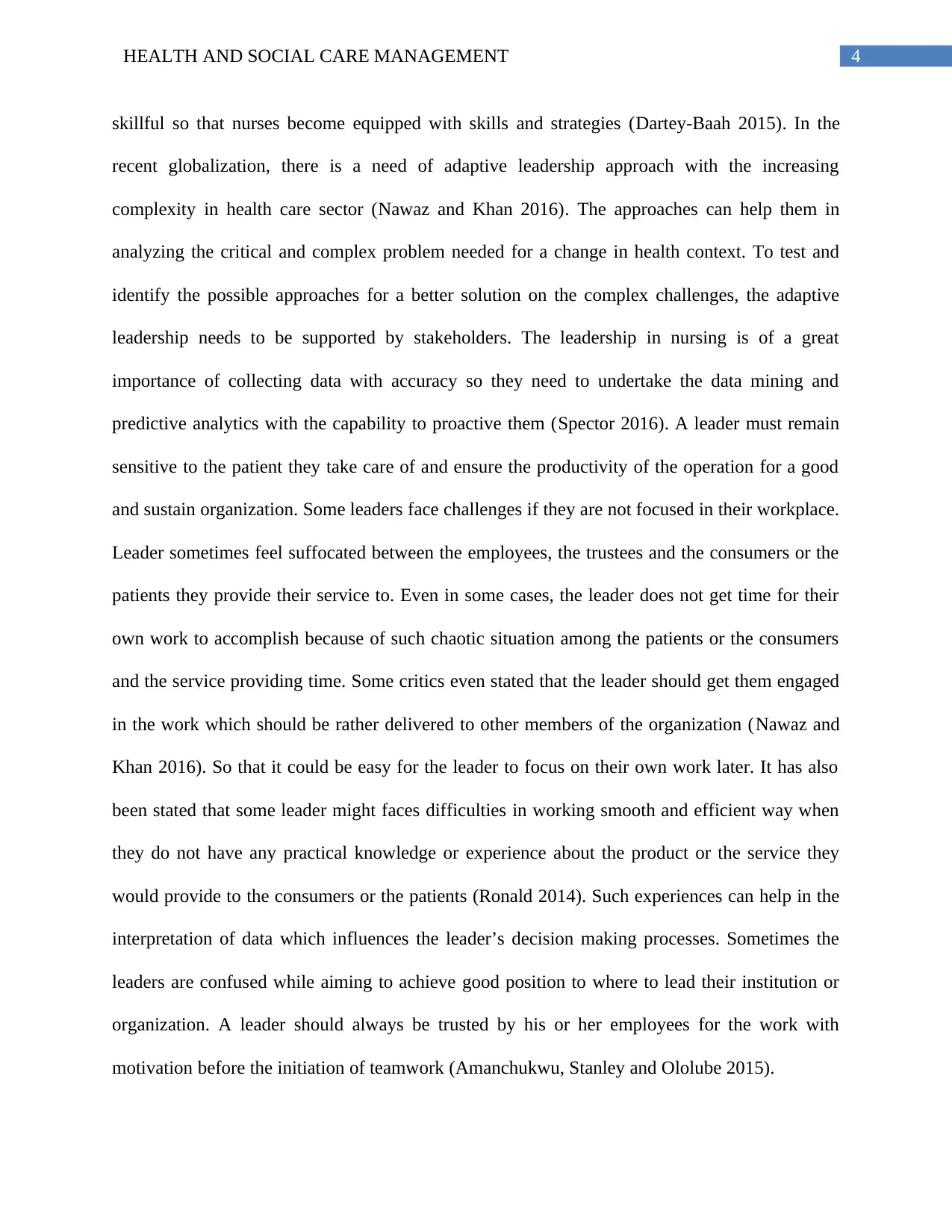
4HEALTH AND SOCIAL CARE MANAGEMENT
skillful so that nurses become equipped with skills and strategies (Dartey-Baah 2015). In the
recent globalization, there is a need of adaptive leadership approach with the increasing
complexity in health care sector (Nawaz and Khan 2016). The approaches can help them in
analyzing the critical and complex problem needed for a change in health context. To test and
identify the possible approaches for a better solution on the complex challenges, the adaptive
leadership needs to be supported by stakeholders. The leadership in nursing is of a great
importance of collecting data with accuracy so they need to undertake the data mining and
predictive analytics with the capability to proactive them (Spector 2016). A leader must remain
sensitive to the patient they take care of and ensure the productivity of the operation for a good
and sustain organization. Some leaders face challenges if they are not focused in their workplace.
Leader sometimes feel suffocated between the employees, the trustees and the consumers or the
patients they provide their service to. Even in some cases, the leader does not get time for their
own work to accomplish because of such chaotic situation among the patients or the consumers
and the service providing time. Some critics even stated that the leader should get them engaged
in the work which should be rather delivered to other members of the organization (Nawaz and
Khan 2016). So that it could be easy for the leader to focus on their own work later. It has also
been stated that some leader might faces difficulties in working smooth and efficient way when
they do not have any practical knowledge or experience about the product or the service they
would provide to the consumers or the patients (Ronald 2014). Such experiences can help in the
interpretation of data which influences the leader’s decision making processes. Sometimes the
leaders are confused while aiming to achieve good position to where to lead their institution or
organization. A leader should always be trusted by his or her employees for the work with
motivation before the initiation of teamwork (Amanchukwu, Stanley and Ololube 2015).
skillful so that nurses become equipped with skills and strategies (Dartey-Baah 2015). In the
recent globalization, there is a need of adaptive leadership approach with the increasing
complexity in health care sector (Nawaz and Khan 2016). The approaches can help them in
analyzing the critical and complex problem needed for a change in health context. To test and
identify the possible approaches for a better solution on the complex challenges, the adaptive
leadership needs to be supported by stakeholders. The leadership in nursing is of a great
importance of collecting data with accuracy so they need to undertake the data mining and
predictive analytics with the capability to proactive them (Spector 2016). A leader must remain
sensitive to the patient they take care of and ensure the productivity of the operation for a good
and sustain organization. Some leaders face challenges if they are not focused in their workplace.
Leader sometimes feel suffocated between the employees, the trustees and the consumers or the
patients they provide their service to. Even in some cases, the leader does not get time for their
own work to accomplish because of such chaotic situation among the patients or the consumers
and the service providing time. Some critics even stated that the leader should get them engaged
in the work which should be rather delivered to other members of the organization (Nawaz and
Khan 2016). So that it could be easy for the leader to focus on their own work later. It has also
been stated that some leader might faces difficulties in working smooth and efficient way when
they do not have any practical knowledge or experience about the product or the service they
would provide to the consumers or the patients (Ronald 2014). Such experiences can help in the
interpretation of data which influences the leader’s decision making processes. Sometimes the
leaders are confused while aiming to achieve good position to where to lead their institution or
organization. A leader should always be trusted by his or her employees for the work with
motivation before the initiation of teamwork (Amanchukwu, Stanley and Ololube 2015).
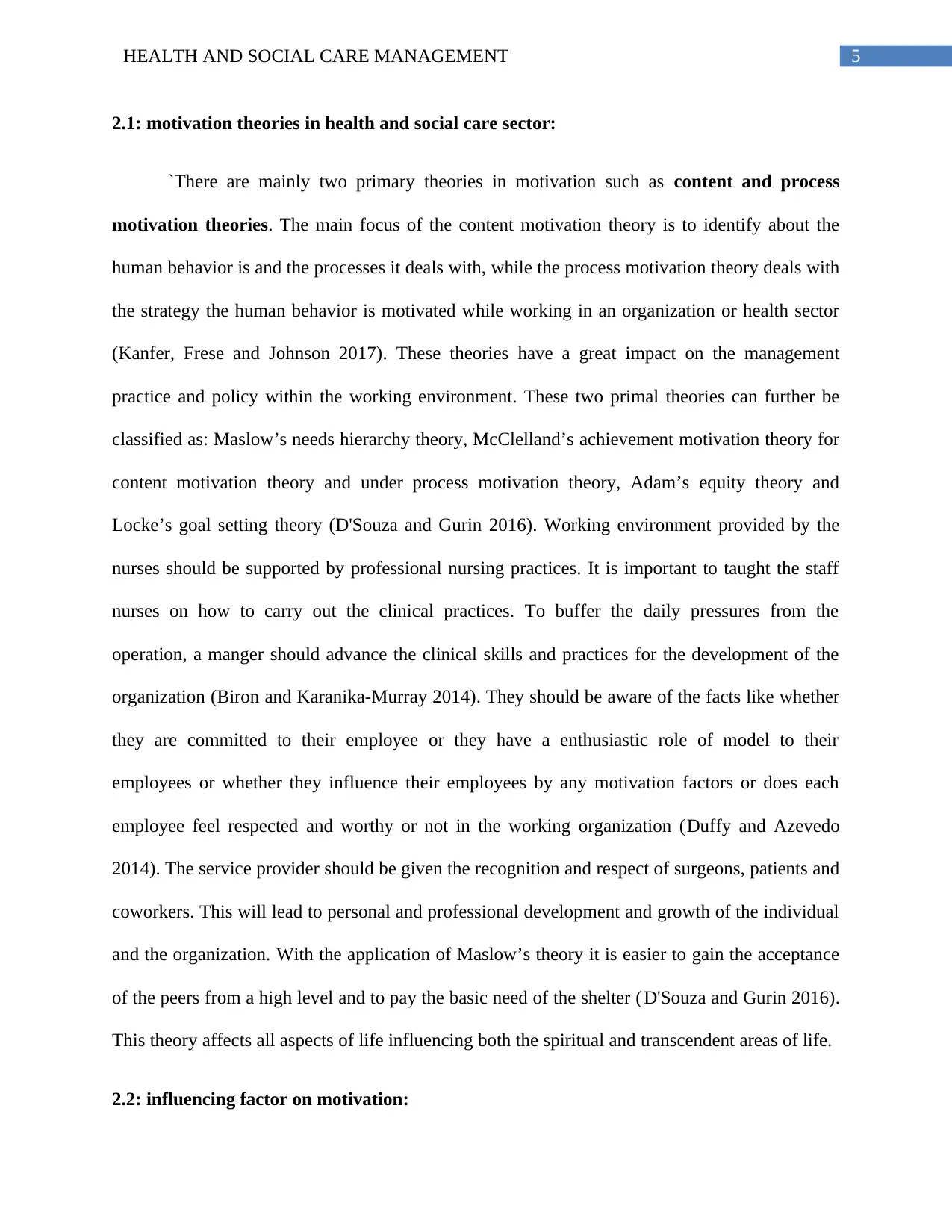
5HEALTH AND SOCIAL CARE MANAGEMENT
2.1: motivation theories in health and social care sector:
`There are mainly two primary theories in motivation such as content and process
motivation theories. The main focus of the content motivation theory is to identify about the
human behavior is and the processes it deals with, while the process motivation theory deals with
the strategy the human behavior is motivated while working in an organization or health sector
(Kanfer, Frese and Johnson 2017). These theories have a great impact on the management
practice and policy within the working environment. These two primal theories can further be
classified as: Maslow’s needs hierarchy theory, McClelland’s achievement motivation theory for
content motivation theory and under process motivation theory, Adam’s equity theory and
Locke’s goal setting theory (D'Souza and Gurin 2016). Working environment provided by the
nurses should be supported by professional nursing practices. It is important to taught the staff
nurses on how to carry out the clinical practices. To buffer the daily pressures from the
operation, a manger should advance the clinical skills and practices for the development of the
organization (Biron and Karanika-Murray 2014). They should be aware of the facts like whether
they are committed to their employee or they have a enthusiastic role of model to their
employees or whether they influence their employees by any motivation factors or does each
employee feel respected and worthy or not in the working organization (Duffy and Azevedo
2014). The service provider should be given the recognition and respect of surgeons, patients and
coworkers. This will lead to personal and professional development and growth of the individual
and the organization. With the application of Maslow’s theory it is easier to gain the acceptance
of the peers from a high level and to pay the basic need of the shelter ( D'Souza and Gurin 2016).
This theory affects all aspects of life influencing both the spiritual and transcendent areas of life.
2.2: influencing factor on motivation:
2.1: motivation theories in health and social care sector:
`There are mainly two primary theories in motivation such as content and process
motivation theories. The main focus of the content motivation theory is to identify about the
human behavior is and the processes it deals with, while the process motivation theory deals with
the strategy the human behavior is motivated while working in an organization or health sector
(Kanfer, Frese and Johnson 2017). These theories have a great impact on the management
practice and policy within the working environment. These two primal theories can further be
classified as: Maslow’s needs hierarchy theory, McClelland’s achievement motivation theory for
content motivation theory and under process motivation theory, Adam’s equity theory and
Locke’s goal setting theory (D'Souza and Gurin 2016). Working environment provided by the
nurses should be supported by professional nursing practices. It is important to taught the staff
nurses on how to carry out the clinical practices. To buffer the daily pressures from the
operation, a manger should advance the clinical skills and practices for the development of the
organization (Biron and Karanika-Murray 2014). They should be aware of the facts like whether
they are committed to their employee or they have a enthusiastic role of model to their
employees or whether they influence their employees by any motivation factors or does each
employee feel respected and worthy or not in the working organization (Duffy and Azevedo
2014). The service provider should be given the recognition and respect of surgeons, patients and
coworkers. This will lead to personal and professional development and growth of the individual
and the organization. With the application of Maslow’s theory it is easier to gain the acceptance
of the peers from a high level and to pay the basic need of the shelter ( D'Souza and Gurin 2016).
This theory affects all aspects of life influencing both the spiritual and transcendent areas of life.
2.2: influencing factor on motivation:
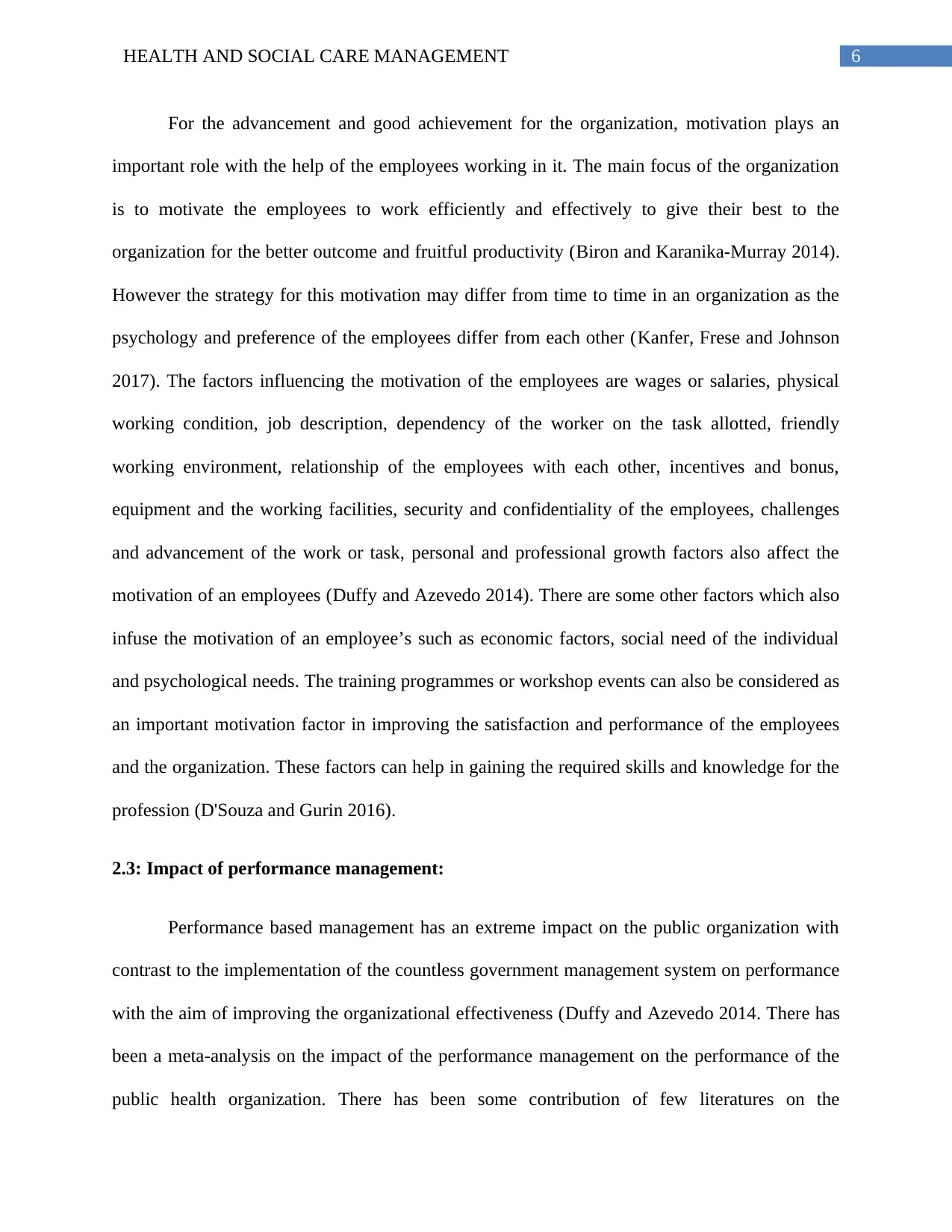
6HEALTH AND SOCIAL CARE MANAGEMENT
For the advancement and good achievement for the organization, motivation plays an
important role with the help of the employees working in it. The main focus of the organization
is to motivate the employees to work efficiently and effectively to give their best to the
organization for the better outcome and fruitful productivity (Biron and Karanika-Murray 2014).
However the strategy for this motivation may differ from time to time in an organization as the
psychology and preference of the employees differ from each other (Kanfer, Frese and Johnson
2017). The factors influencing the motivation of the employees are wages or salaries, physical
working condition, job description, dependency of the worker on the task allotted, friendly
working environment, relationship of the employees with each other, incentives and bonus,
equipment and the working facilities, security and confidentiality of the employees, challenges
and advancement of the work or task, personal and professional growth factors also affect the
motivation of an employees (Duffy and Azevedo 2014). There are some other factors which also
infuse the motivation of an employee’s such as economic factors, social need of the individual
and psychological needs. The training programmes or workshop events can also be considered as
an important motivation factor in improving the satisfaction and performance of the employees
and the organization. These factors can help in gaining the required skills and knowledge for the
profession (D'Souza and Gurin 2016).
2.3: Impact of performance management:
Performance based management has an extreme impact on the public organization with
contrast to the implementation of the countless government management system on performance
with the aim of improving the organizational effectiveness (Duffy and Azevedo 2014. There has
been a meta-analysis on the impact of the performance management on the performance of the
public health organization. There has been some contribution of few literatures on the
For the advancement and good achievement for the organization, motivation plays an
important role with the help of the employees working in it. The main focus of the organization
is to motivate the employees to work efficiently and effectively to give their best to the
organization for the better outcome and fruitful productivity (Biron and Karanika-Murray 2014).
However the strategy for this motivation may differ from time to time in an organization as the
psychology and preference of the employees differ from each other (Kanfer, Frese and Johnson
2017). The factors influencing the motivation of the employees are wages or salaries, physical
working condition, job description, dependency of the worker on the task allotted, friendly
working environment, relationship of the employees with each other, incentives and bonus,
equipment and the working facilities, security and confidentiality of the employees, challenges
and advancement of the work or task, personal and professional growth factors also affect the
motivation of an employees (Duffy and Azevedo 2014). There are some other factors which also
infuse the motivation of an employee’s such as economic factors, social need of the individual
and psychological needs. The training programmes or workshop events can also be considered as
an important motivation factor in improving the satisfaction and performance of the employees
and the organization. These factors can help in gaining the required skills and knowledge for the
profession (D'Souza and Gurin 2016).
2.3: Impact of performance management:
Performance based management has an extreme impact on the public organization with
contrast to the implementation of the countless government management system on performance
with the aim of improving the organizational effectiveness (Duffy and Azevedo 2014. There has
been a meta-analysis on the impact of the performance management on the performance of the
public health organization. There has been some contribution of few literatures on the
Paraphrase This Document
Need a fresh take? Get an instant paraphrase of this document with our AI Paraphraser
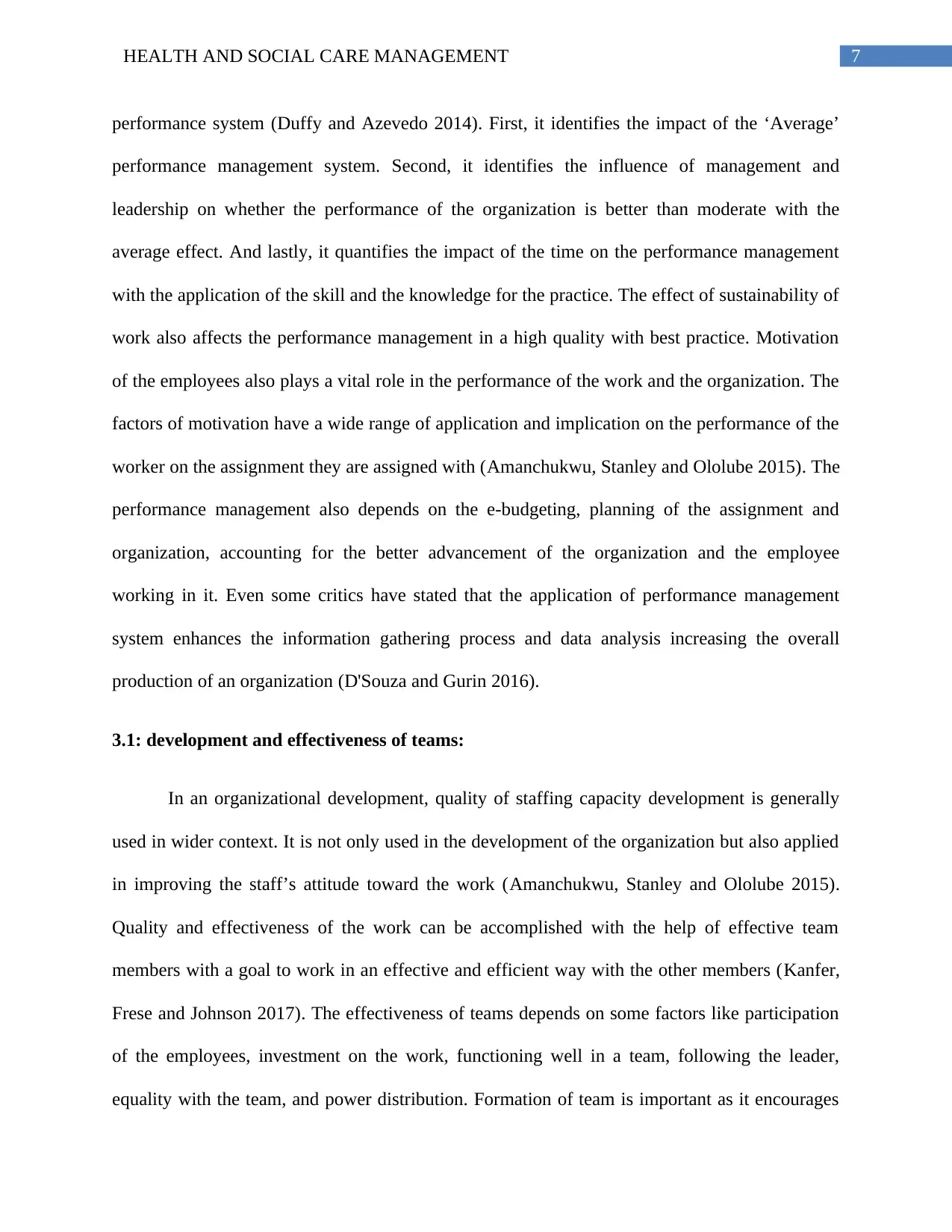
7HEALTH AND SOCIAL CARE MANAGEMENT
performance system (Duffy and Azevedo 2014). First, it identifies the impact of the ‘Average’
performance management system. Second, it identifies the influence of management and
leadership on whether the performance of the organization is better than moderate with the
average effect. And lastly, it quantifies the impact of the time on the performance management
with the application of the skill and the knowledge for the practice. The effect of sustainability of
work also affects the performance management in a high quality with best practice. Motivation
of the employees also plays a vital role in the performance of the work and the organization. The
factors of motivation have a wide range of application and implication on the performance of the
worker on the assignment they are assigned with (Amanchukwu, Stanley and Ololube 2015). The
performance management also depends on the e-budgeting, planning of the assignment and
organization, accounting for the better advancement of the organization and the employee
working in it. Even some critics have stated that the application of performance management
system enhances the information gathering process and data analysis increasing the overall
production of an organization (D'Souza and Gurin 2016).
3.1: development and effectiveness of teams:
In an organizational development, quality of staffing capacity development is generally
used in wider context. It is not only used in the development of the organization but also applied
in improving the staff’s attitude toward the work (Amanchukwu, Stanley and Ololube 2015).
Quality and effectiveness of the work can be accomplished with the help of effective team
members with a goal to work in an effective and efficient way with the other members (Kanfer,
Frese and Johnson 2017). The effectiveness of teams depends on some factors like participation
of the employees, investment on the work, functioning well in a team, following the leader,
equality with the team, and power distribution. Formation of team is important as it encourages
performance system (Duffy and Azevedo 2014). First, it identifies the impact of the ‘Average’
performance management system. Second, it identifies the influence of management and
leadership on whether the performance of the organization is better than moderate with the
average effect. And lastly, it quantifies the impact of the time on the performance management
with the application of the skill and the knowledge for the practice. The effect of sustainability of
work also affects the performance management in a high quality with best practice. Motivation
of the employees also plays a vital role in the performance of the work and the organization. The
factors of motivation have a wide range of application and implication on the performance of the
worker on the assignment they are assigned with (Amanchukwu, Stanley and Ololube 2015). The
performance management also depends on the e-budgeting, planning of the assignment and
organization, accounting for the better advancement of the organization and the employee
working in it. Even some critics have stated that the application of performance management
system enhances the information gathering process and data analysis increasing the overall
production of an organization (D'Souza and Gurin 2016).
3.1: development and effectiveness of teams:
In an organizational development, quality of staffing capacity development is generally
used in wider context. It is not only used in the development of the organization but also applied
in improving the staff’s attitude toward the work (Amanchukwu, Stanley and Ololube 2015).
Quality and effectiveness of the work can be accomplished with the help of effective team
members with a goal to work in an effective and efficient way with the other members (Kanfer,
Frese and Johnson 2017). The effectiveness of teams depends on some factors like participation
of the employees, investment on the work, functioning well in a team, following the leader,
equality with the team, and power distribution. Formation of team is important as it encourages
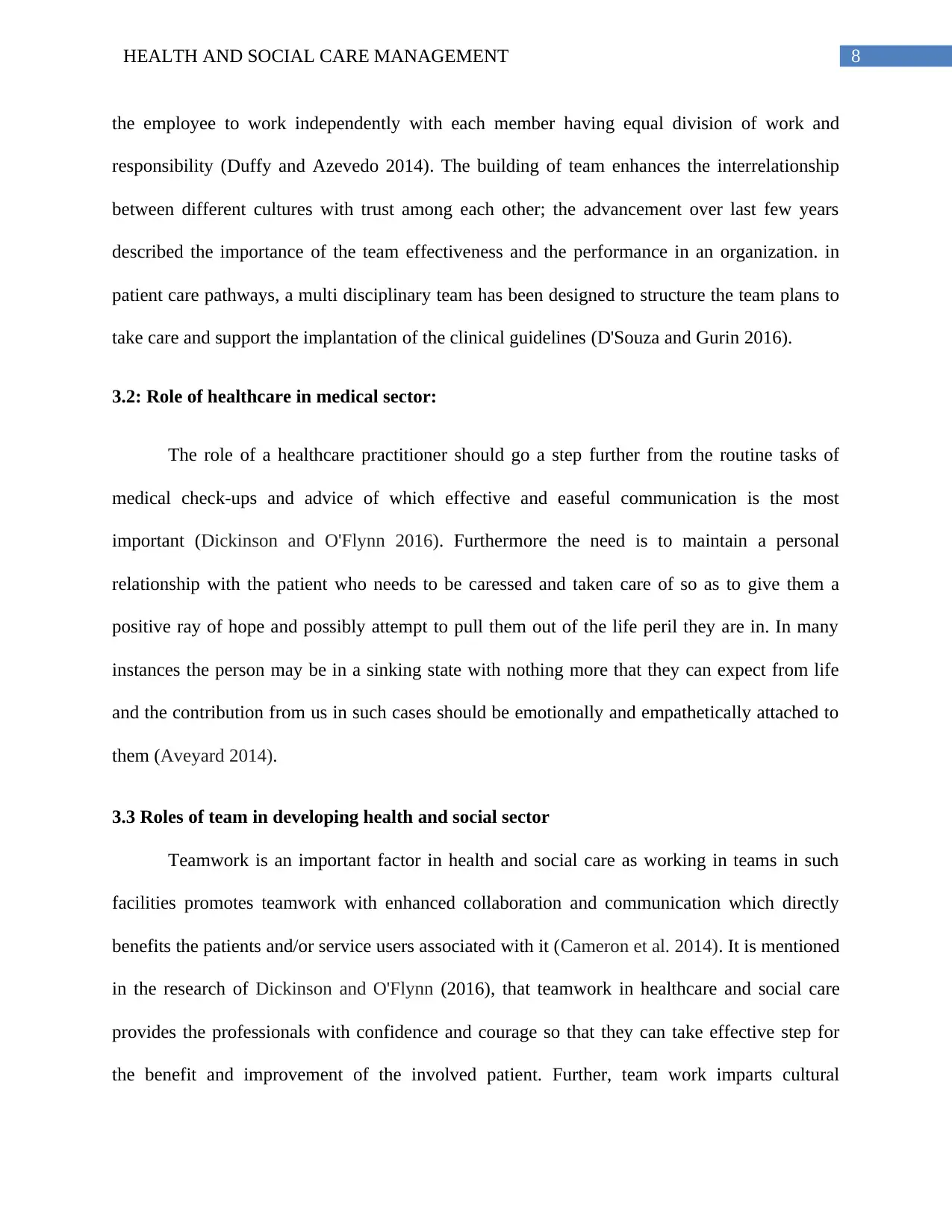
8HEALTH AND SOCIAL CARE MANAGEMENT
the employee to work independently with each member having equal division of work and
responsibility (Duffy and Azevedo 2014). The building of team enhances the interrelationship
between different cultures with trust among each other; the advancement over last few years
described the importance of the team effectiveness and the performance in an organization. in
patient care pathways, a multi disciplinary team has been designed to structure the team plans to
take care and support the implantation of the clinical guidelines (D'Souza and Gurin 2016).
3.2: Role of healthcare in medical sector:
The role of a healthcare practitioner should go a step further from the routine tasks of
medical check-ups and advice of which effective and easeful communication is the most
important (Dickinson and O'Flynn 2016). Furthermore the need is to maintain a personal
relationship with the patient who needs to be caressed and taken care of so as to give them a
positive ray of hope and possibly attempt to pull them out of the life peril they are in. In many
instances the person may be in a sinking state with nothing more that they can expect from life
and the contribution from us in such cases should be emotionally and empathetically attached to
them (Aveyard 2014).
3.3 Roles of team in developing health and social sector
Teamwork is an important factor in health and social care as working in teams in such
facilities promotes teamwork with enhanced collaboration and communication which directly
benefits the patients and/or service users associated with it (Cameron et al. 2014). It is mentioned
in the research of Dickinson and O'Flynn (2016), that teamwork in healthcare and social care
provides the professionals with confidence and courage so that they can take effective step for
the benefit and improvement of the involved patient. Further, team work imparts cultural
the employee to work independently with each member having equal division of work and
responsibility (Duffy and Azevedo 2014). The building of team enhances the interrelationship
between different cultures with trust among each other; the advancement over last few years
described the importance of the team effectiveness and the performance in an organization. in
patient care pathways, a multi disciplinary team has been designed to structure the team plans to
take care and support the implantation of the clinical guidelines (D'Souza and Gurin 2016).
3.2: Role of healthcare in medical sector:
The role of a healthcare practitioner should go a step further from the routine tasks of
medical check-ups and advice of which effective and easeful communication is the most
important (Dickinson and O'Flynn 2016). Furthermore the need is to maintain a personal
relationship with the patient who needs to be caressed and taken care of so as to give them a
positive ray of hope and possibly attempt to pull them out of the life peril they are in. In many
instances the person may be in a sinking state with nothing more that they can expect from life
and the contribution from us in such cases should be emotionally and empathetically attached to
them (Aveyard 2014).
3.3 Roles of team in developing health and social sector
Teamwork is an important factor in health and social care as working in teams in such
facilities promotes teamwork with enhanced collaboration and communication which directly
benefits the patients and/or service users associated with it (Cameron et al. 2014). It is mentioned
in the research of Dickinson and O'Flynn (2016), that teamwork in healthcare and social care
provides the professionals with confidence and courage so that they can take effective step for
the benefit and improvement of the involved patient. Further, team work imparts cultural
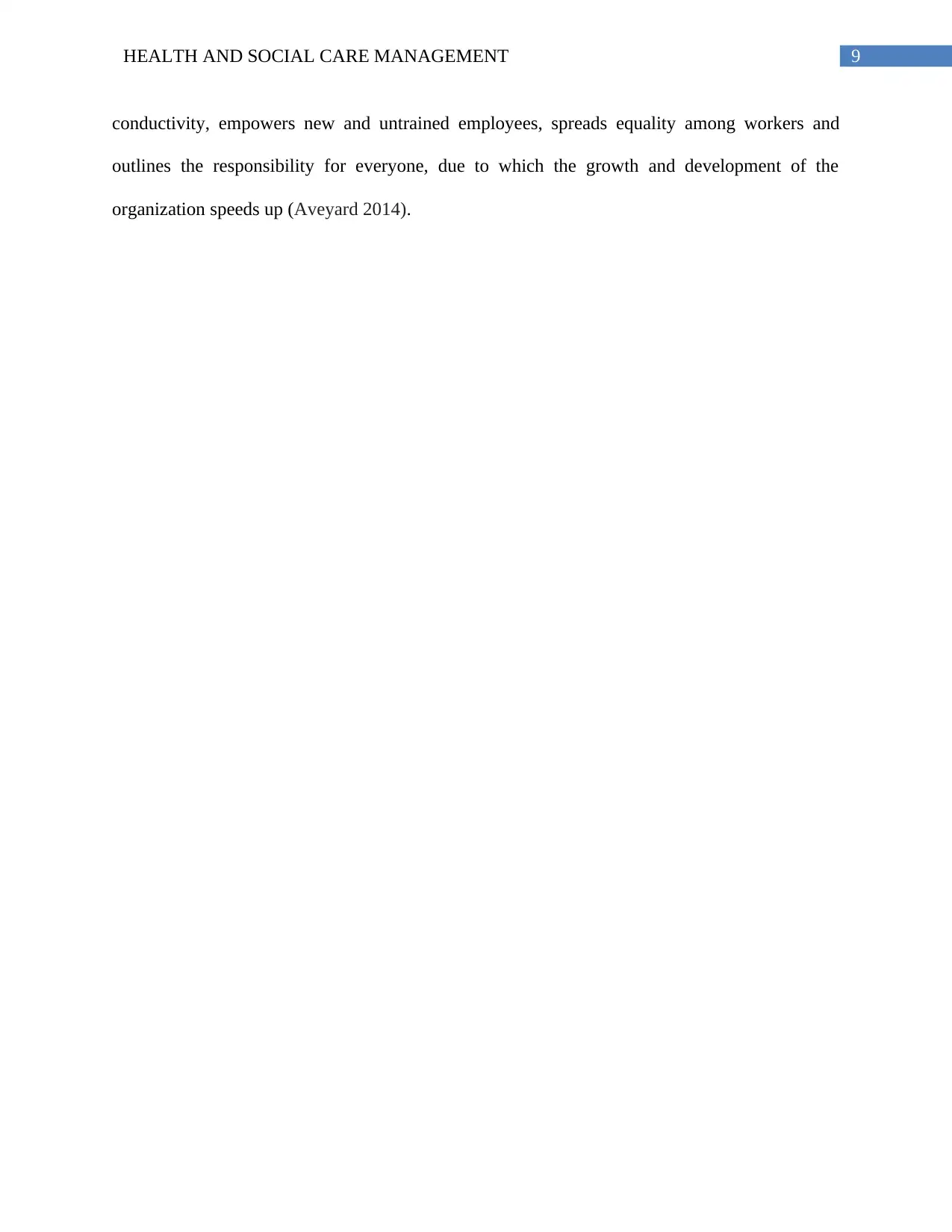
9HEALTH AND SOCIAL CARE MANAGEMENT
conductivity, empowers new and untrained employees, spreads equality among workers and
outlines the responsibility for everyone, due to which the growth and development of the
organization speeds up (Aveyard 2014).
conductivity, empowers new and untrained employees, spreads equality among workers and
outlines the responsibility for everyone, due to which the growth and development of the
organization speeds up (Aveyard 2014).
Secure Best Marks with AI Grader
Need help grading? Try our AI Grader for instant feedback on your assignments.
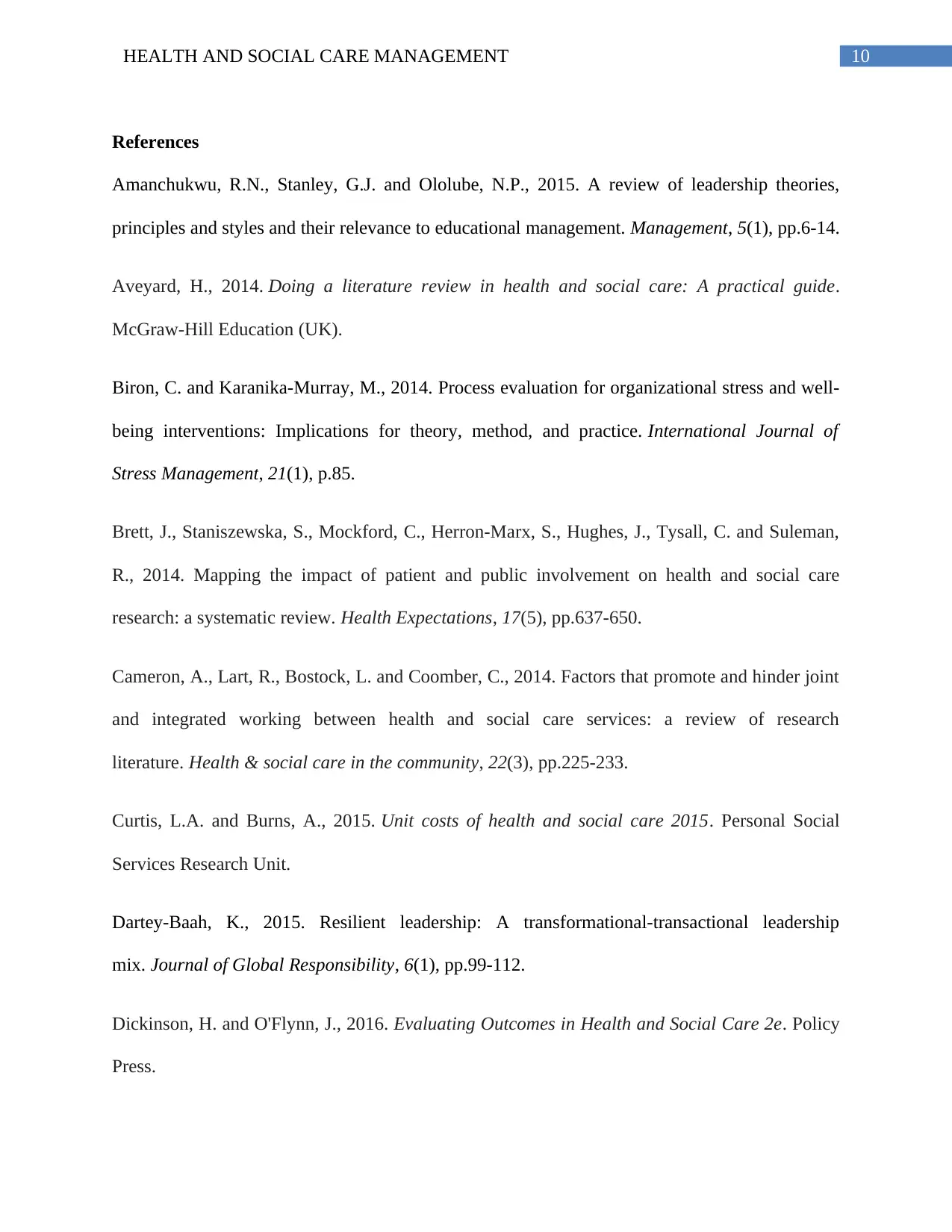
10HEALTH AND SOCIAL CARE MANAGEMENT
References
Amanchukwu, R.N., Stanley, G.J. and Ololube, N.P., 2015. A review of leadership theories,
principles and styles and their relevance to educational management. Management, 5(1), pp.6-14.
Aveyard, H., 2014. Doing a literature review in health and social care: A practical guide.
McGraw-Hill Education (UK).
Biron, C. and Karanika-Murray, M., 2014. Process evaluation for organizational stress and well-
being interventions: Implications for theory, method, and practice. International Journal of
Stress Management, 21(1), p.85.
Brett, J., Staniszewska, S., Mockford, C., Herron‐Marx, S., Hughes, J., Tysall, C. and Suleman,
R., 2014. Mapping the impact of patient and public involvement on health and social care
research: a systematic review. Health Expectations, 17(5), pp.637-650.
Cameron, A., Lart, R., Bostock, L. and Coomber, C., 2014. Factors that promote and hinder joint
and integrated working between health and social care services: a review of research
literature. Health & social care in the community, 22(3), pp.225-233.
Curtis, L.A. and Burns, A., 2015. Unit costs of health and social care 2015. Personal Social
Services Research Unit.
Dartey-Baah, K., 2015. Resilient leadership: A transformational-transactional leadership
mix. Journal of Global Responsibility, 6(1), pp.99-112.
Dickinson, H. and O'Flynn, J., 2016. Evaluating Outcomes in Health and Social Care 2e. Policy
Press.
References
Amanchukwu, R.N., Stanley, G.J. and Ololube, N.P., 2015. A review of leadership theories,
principles and styles and their relevance to educational management. Management, 5(1), pp.6-14.
Aveyard, H., 2014. Doing a literature review in health and social care: A practical guide.
McGraw-Hill Education (UK).
Biron, C. and Karanika-Murray, M., 2014. Process evaluation for organizational stress and well-
being interventions: Implications for theory, method, and practice. International Journal of
Stress Management, 21(1), p.85.
Brett, J., Staniszewska, S., Mockford, C., Herron‐Marx, S., Hughes, J., Tysall, C. and Suleman,
R., 2014. Mapping the impact of patient and public involvement on health and social care
research: a systematic review. Health Expectations, 17(5), pp.637-650.
Cameron, A., Lart, R., Bostock, L. and Coomber, C., 2014. Factors that promote and hinder joint
and integrated working between health and social care services: a review of research
literature. Health & social care in the community, 22(3), pp.225-233.
Curtis, L.A. and Burns, A., 2015. Unit costs of health and social care 2015. Personal Social
Services Research Unit.
Dartey-Baah, K., 2015. Resilient leadership: A transformational-transactional leadership
mix. Journal of Global Responsibility, 6(1), pp.99-112.
Dickinson, H. and O'Flynn, J., 2016. Evaluating Outcomes in Health and Social Care 2e. Policy
Press.
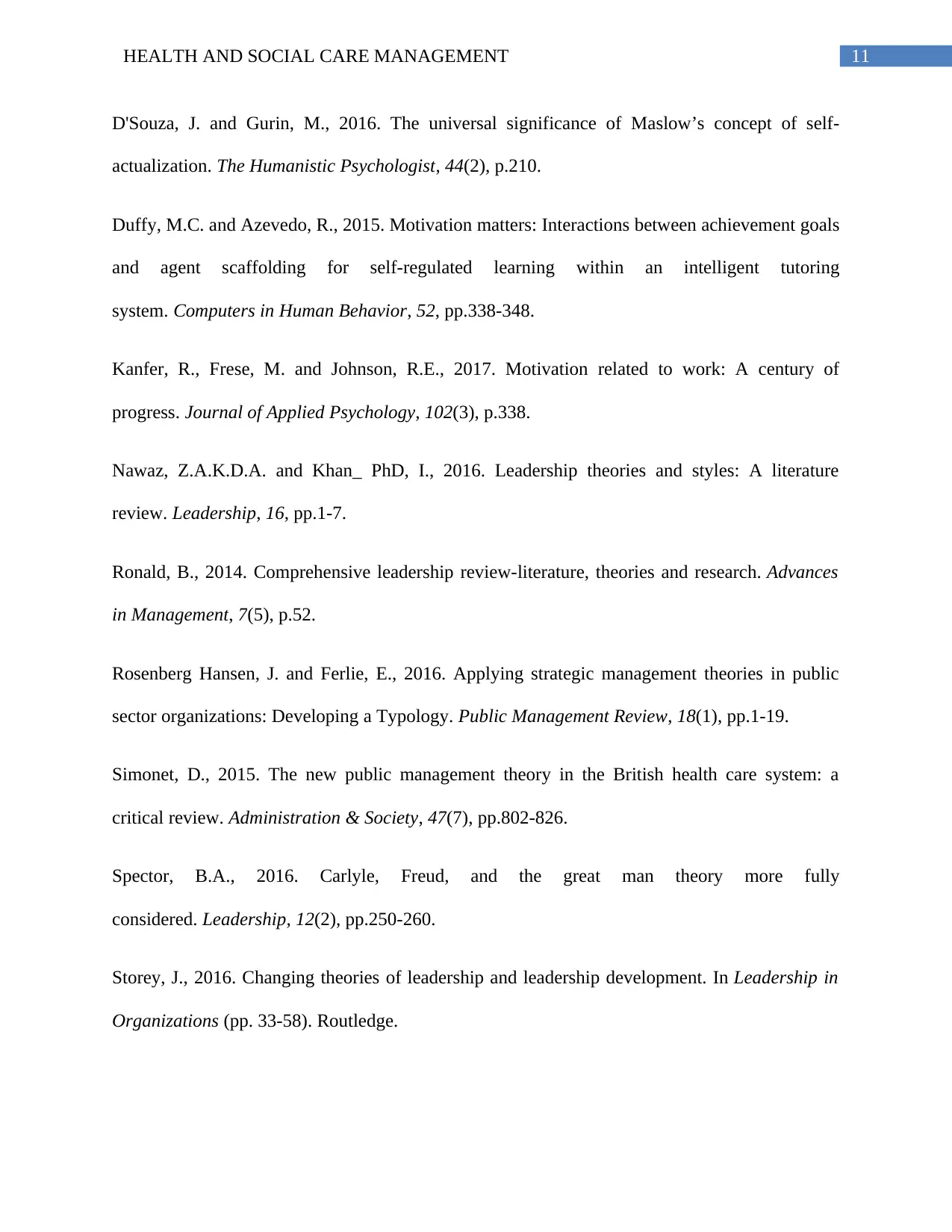
11HEALTH AND SOCIAL CARE MANAGEMENT
D'Souza, J. and Gurin, M., 2016. The universal significance of Maslow’s concept of self-
actualization. The Humanistic Psychologist, 44(2), p.210.
Duffy, M.C. and Azevedo, R., 2015. Motivation matters: Interactions between achievement goals
and agent scaffolding for self-regulated learning within an intelligent tutoring
system. Computers in Human Behavior, 52, pp.338-348.
Kanfer, R., Frese, M. and Johnson, R.E., 2017. Motivation related to work: A century of
progress. Journal of Applied Psychology, 102(3), p.338.
Nawaz, Z.A.K.D.A. and Khan_ PhD, I., 2016. Leadership theories and styles: A literature
review. Leadership, 16, pp.1-7.
Ronald, B., 2014. Comprehensive leadership review-literature, theories and research. Advances
in Management, 7(5), p.52.
Rosenberg Hansen, J. and Ferlie, E., 2016. Applying strategic management theories in public
sector organizations: Developing a Typology. Public Management Review, 18(1), pp.1-19.
Simonet, D., 2015. The new public management theory in the British health care system: a
critical review. Administration & Society, 47(7), pp.802-826.
Spector, B.A., 2016. Carlyle, Freud, and the great man theory more fully
considered. Leadership, 12(2), pp.250-260.
Storey, J., 2016. Changing theories of leadership and leadership development. In Leadership in
Organizations (pp. 33-58). Routledge.
D'Souza, J. and Gurin, M., 2016. The universal significance of Maslow’s concept of self-
actualization. The Humanistic Psychologist, 44(2), p.210.
Duffy, M.C. and Azevedo, R., 2015. Motivation matters: Interactions between achievement goals
and agent scaffolding for self-regulated learning within an intelligent tutoring
system. Computers in Human Behavior, 52, pp.338-348.
Kanfer, R., Frese, M. and Johnson, R.E., 2017. Motivation related to work: A century of
progress. Journal of Applied Psychology, 102(3), p.338.
Nawaz, Z.A.K.D.A. and Khan_ PhD, I., 2016. Leadership theories and styles: A literature
review. Leadership, 16, pp.1-7.
Ronald, B., 2014. Comprehensive leadership review-literature, theories and research. Advances
in Management, 7(5), p.52.
Rosenberg Hansen, J. and Ferlie, E., 2016. Applying strategic management theories in public
sector organizations: Developing a Typology. Public Management Review, 18(1), pp.1-19.
Simonet, D., 2015. The new public management theory in the British health care system: a
critical review. Administration & Society, 47(7), pp.802-826.
Spector, B.A., 2016. Carlyle, Freud, and the great man theory more fully
considered. Leadership, 12(2), pp.250-260.
Storey, J., 2016. Changing theories of leadership and leadership development. In Leadership in
Organizations (pp. 33-58). Routledge.
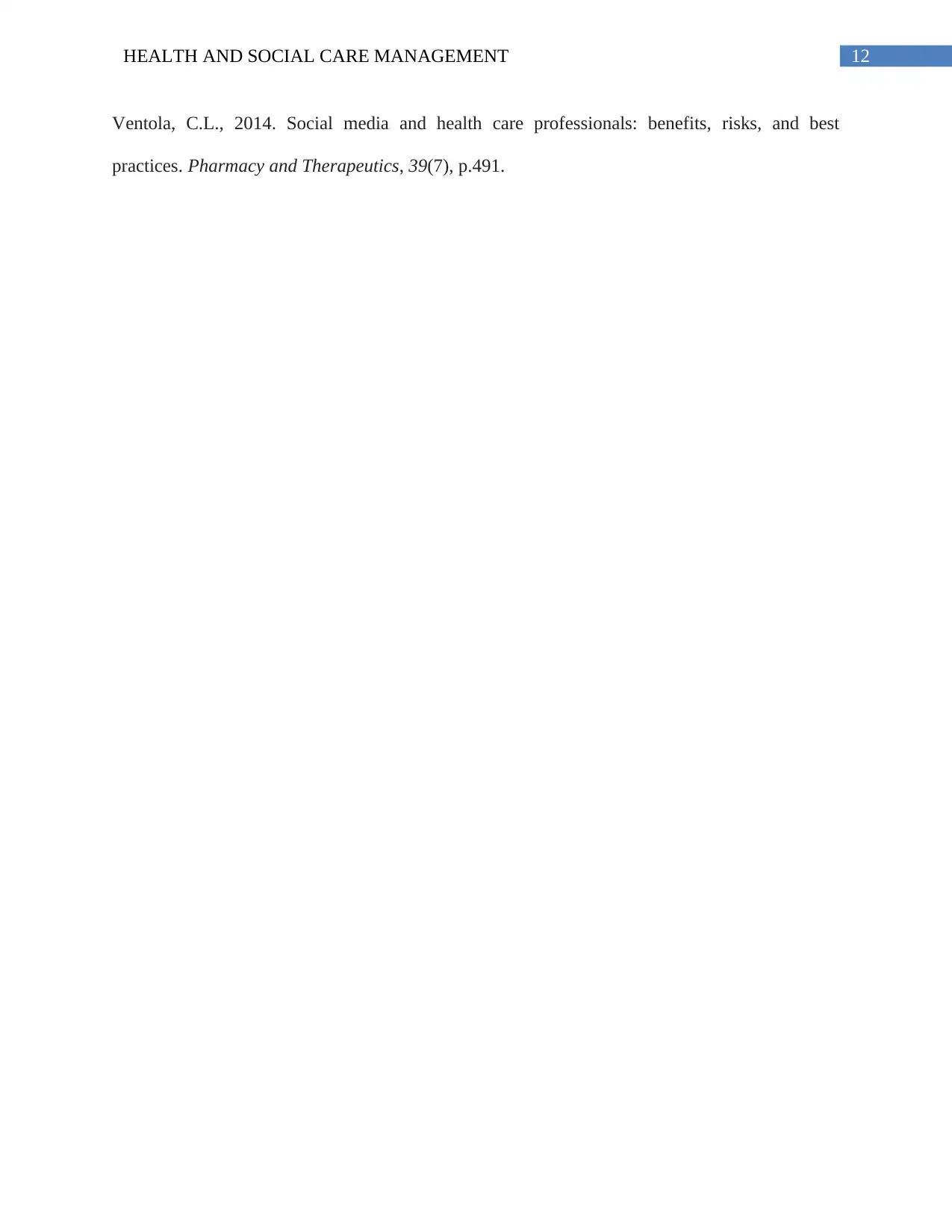
12HEALTH AND SOCIAL CARE MANAGEMENT
Ventola, C.L., 2014. Social media and health care professionals: benefits, risks, and best
practices. Pharmacy and Therapeutics, 39(7), p.491.
Ventola, C.L., 2014. Social media and health care professionals: benefits, risks, and best
practices. Pharmacy and Therapeutics, 39(7), p.491.
1 out of 13
Related Documents
Your All-in-One AI-Powered Toolkit for Academic Success.
+13062052269
info@desklib.com
Available 24*7 on WhatsApp / Email
![[object Object]](/_next/static/media/star-bottom.7253800d.svg)
Unlock your academic potential
© 2024 | Zucol Services PVT LTD | All rights reserved.





